Abstract
1. BW A868C, a novel compound, behaved as a simple competitive antagonist in a human washed platelet aggregation assay. Anti-aggregatory concentration-effect curves to BW 245C were displaced in a parallel manner. The shifts accorded with a Schild plot slope of unity and a pKB of 9.26. 2. Inhibition of platelet aggregation by prostaglandin D2 (PGD2) was antagonized with a similar potency, as were the relaxation effects of BW 245C and PGD2 in the rabbit jugular vein. BW A868C can, therefore, be classified as a DP-receptor antagonist. 3. Actions of BW A868C at other prostaglandin receptors (IP, EP1, EP2, TP and FP) were excluded at concentrations up to 1,000 times higher than the DP-receptor affinity. 4. Analyses of BW 245C- and PGD2-mediated effects were complicated by additional agonist receptor interactions which were revealed by BW A868C. In rabbit jugular vein a resistant phase of agonism was detectable, indicating that both agonists exerted effects through another receptor (possibly EP2). Also, PGD2, in addition to its anti-aggregatory effect on platelets, demonstrated a pro-aggregatory action in the presence of BW A868C. 5. The contractile effects of PGD2 in guinea-pig tracheal strips were resistant to 10 microM BW A868C indicating that they were not mediated through DP-receptors. 6. To our knowledge this is the first account of a well-classified competitive antagonist at the DP-receptor. Its potency and selectivity make it an important new tool in prostanoid receptor classification and identification.
Full text
PDF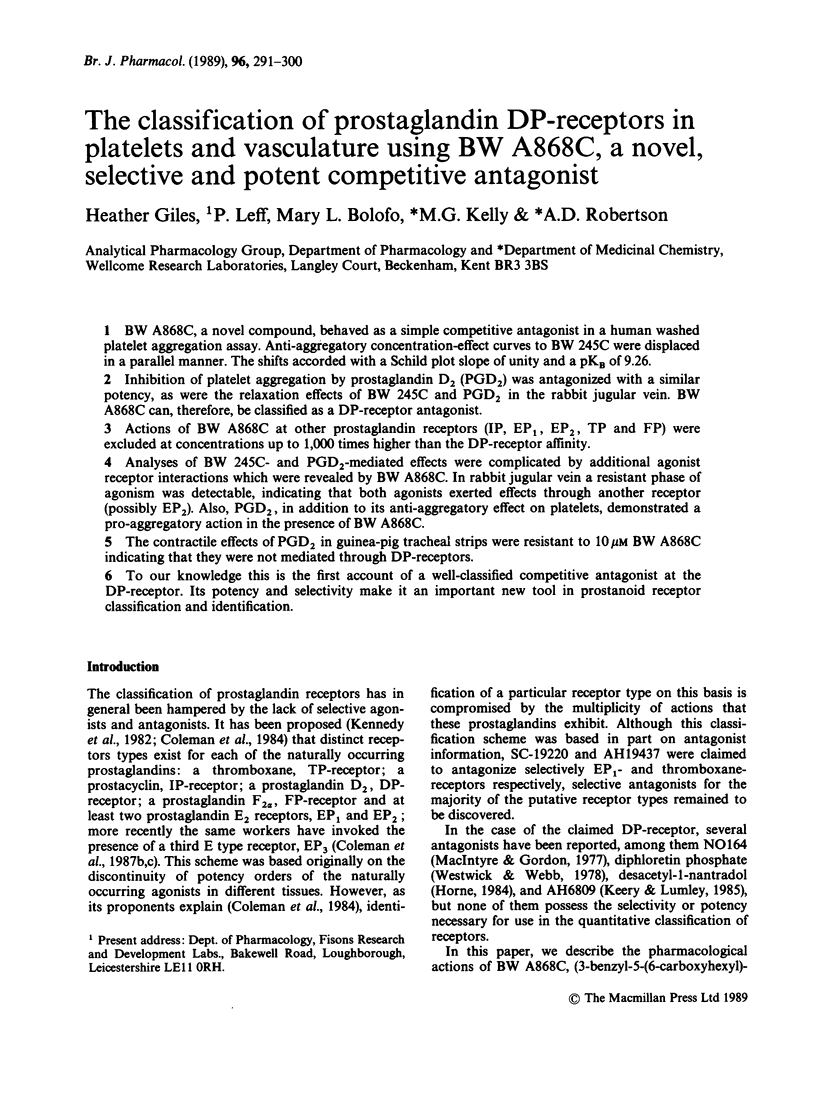
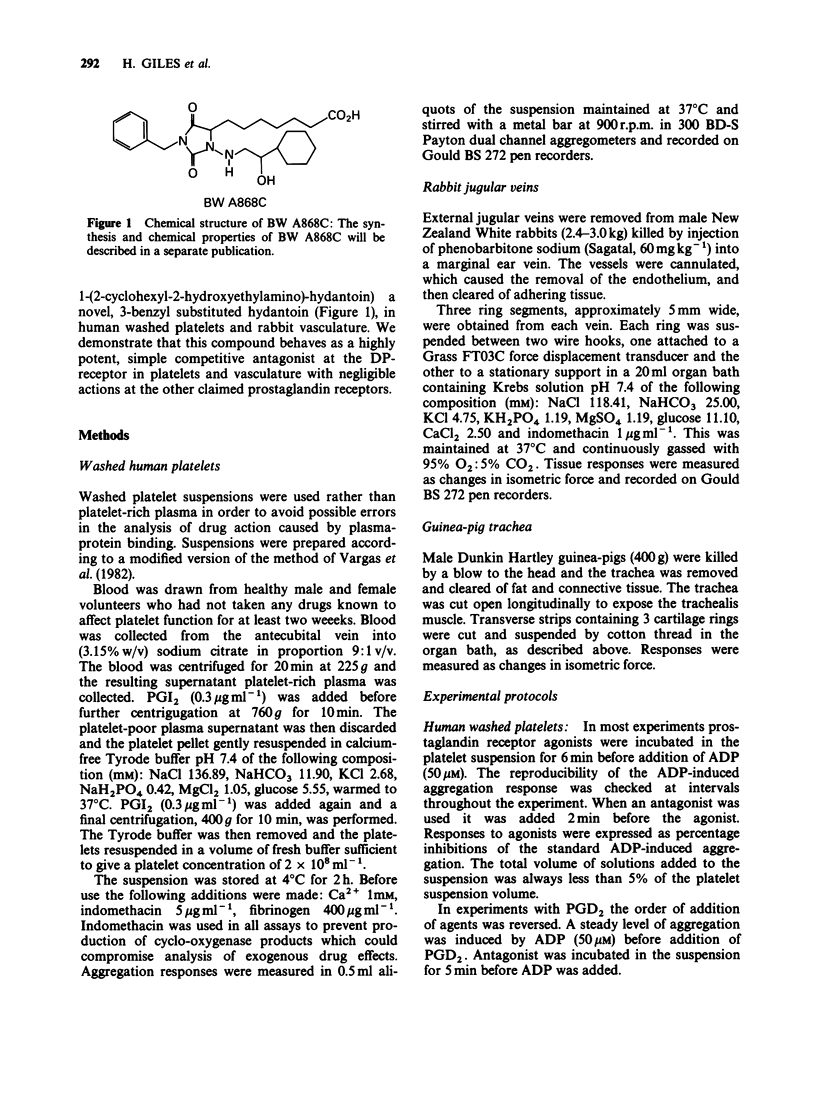
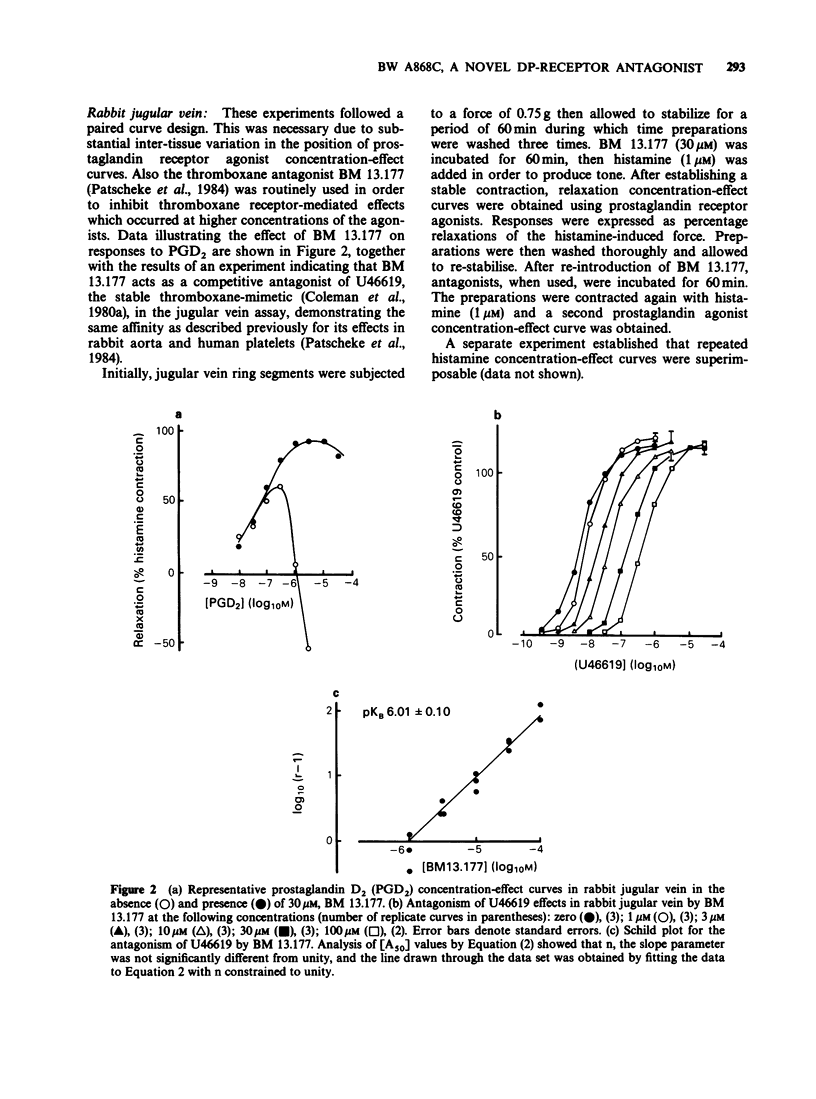
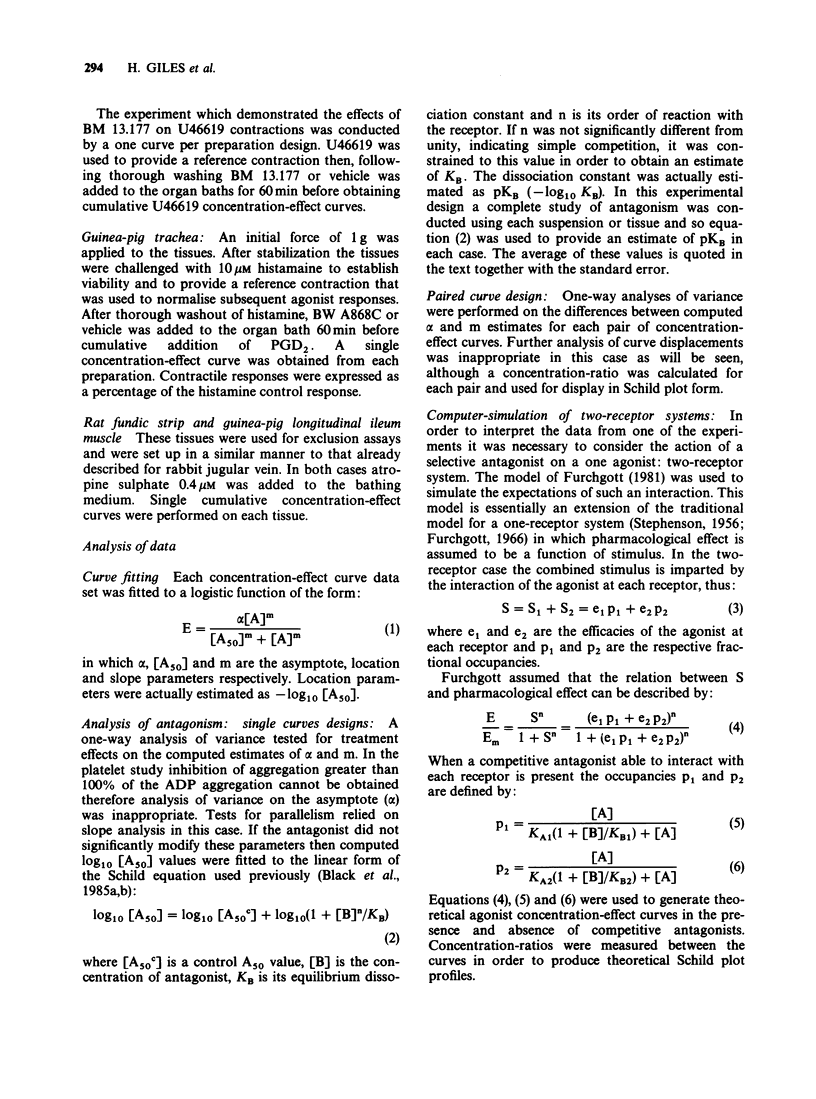
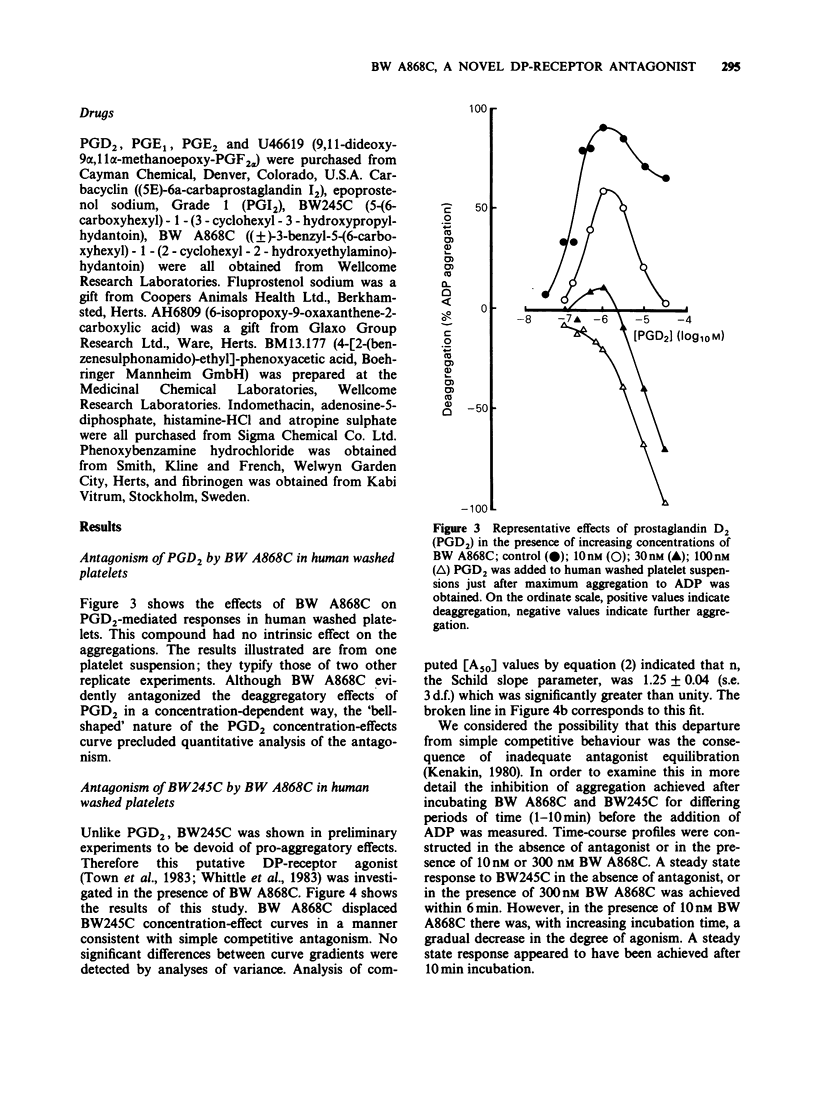
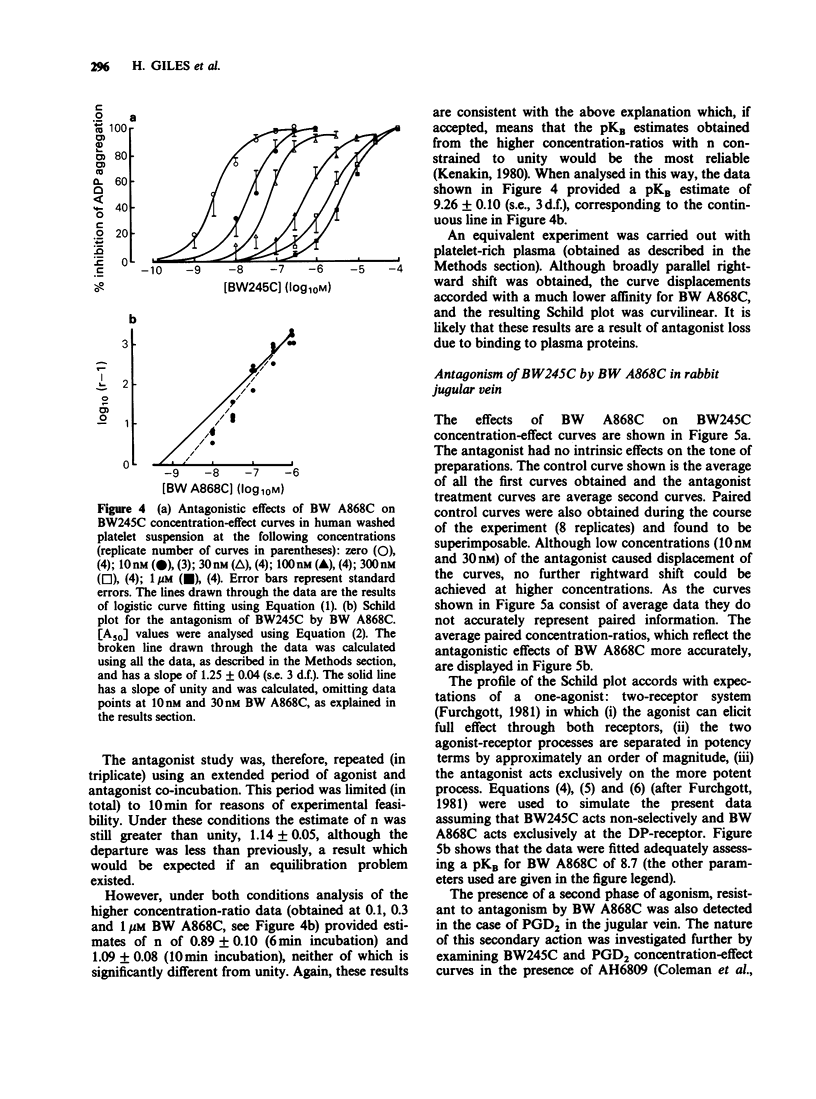
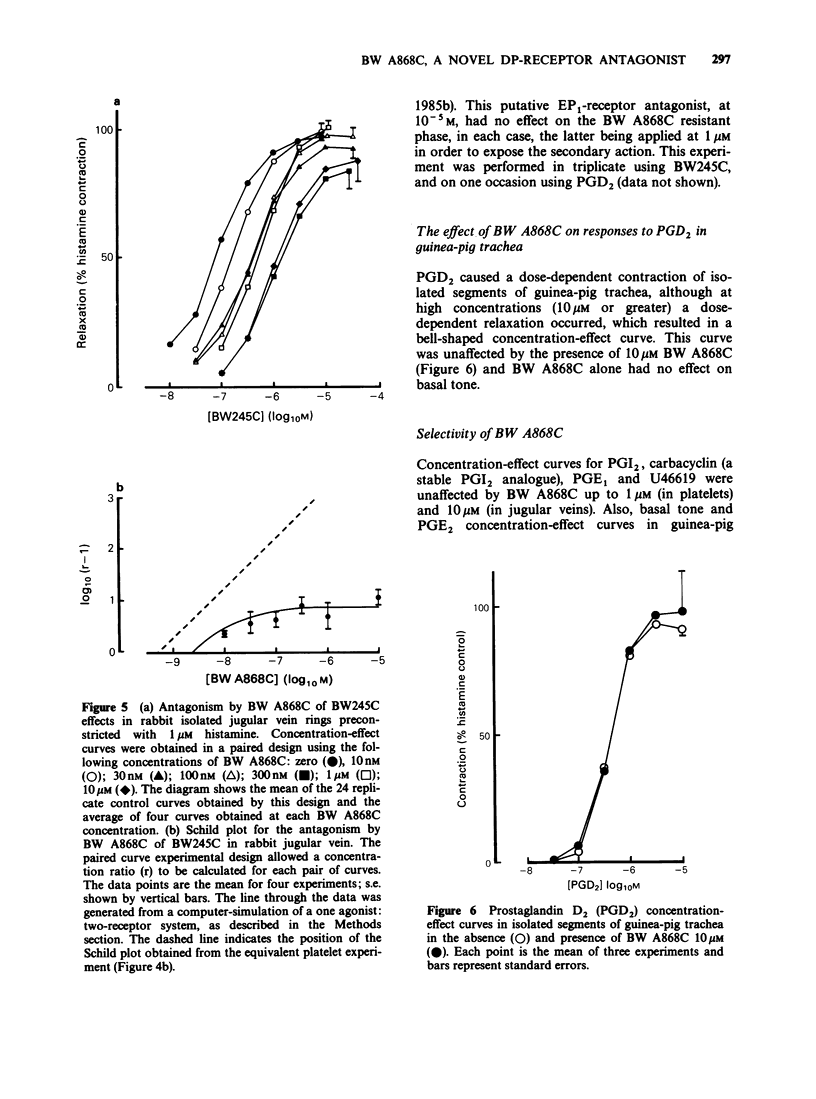
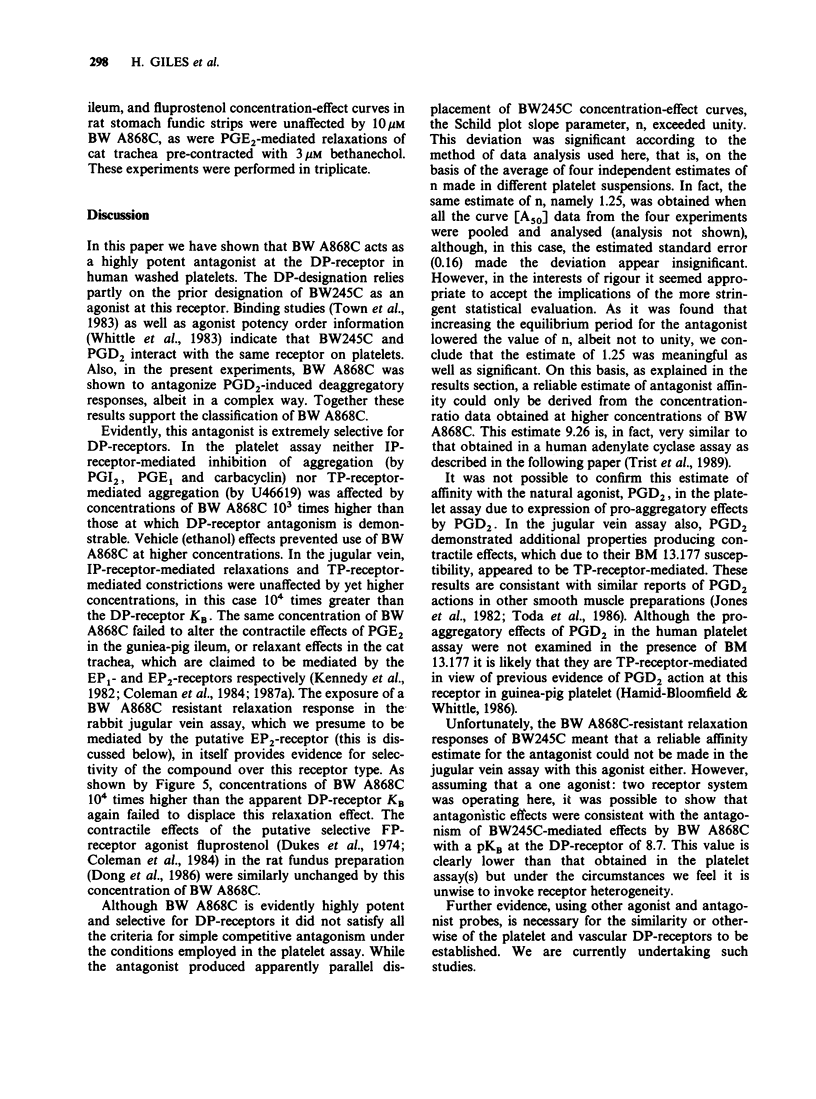
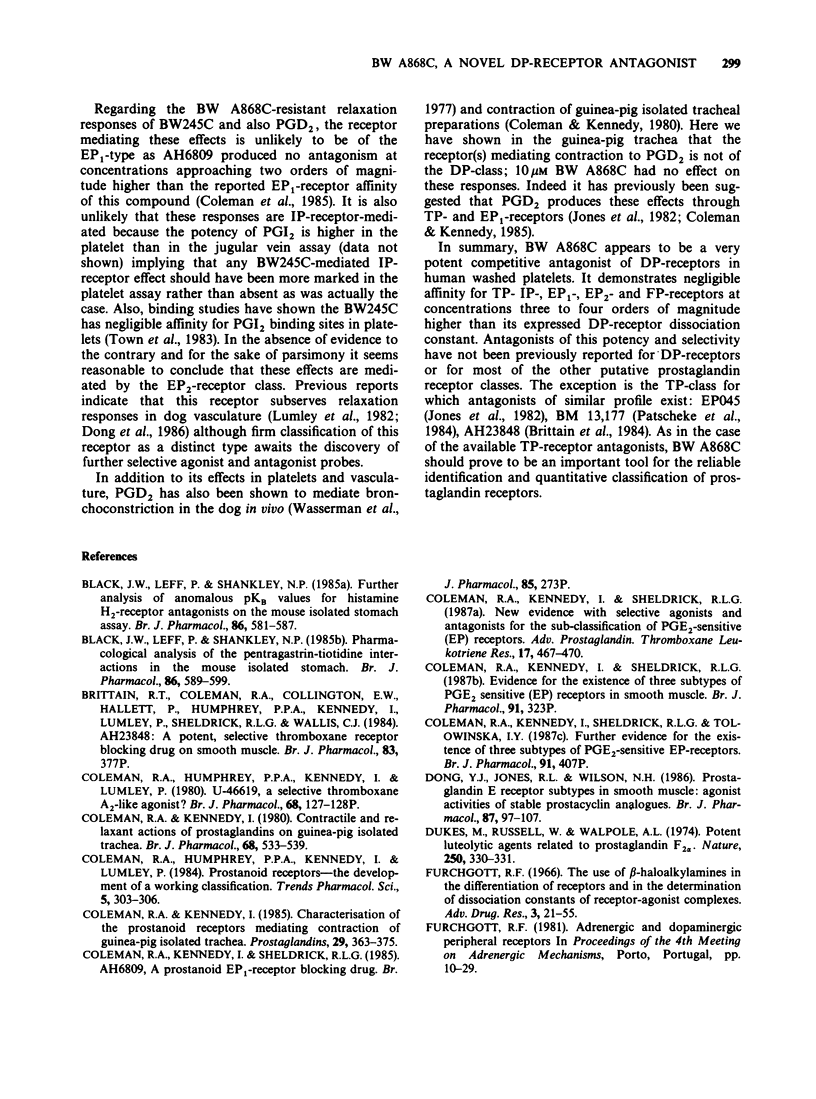
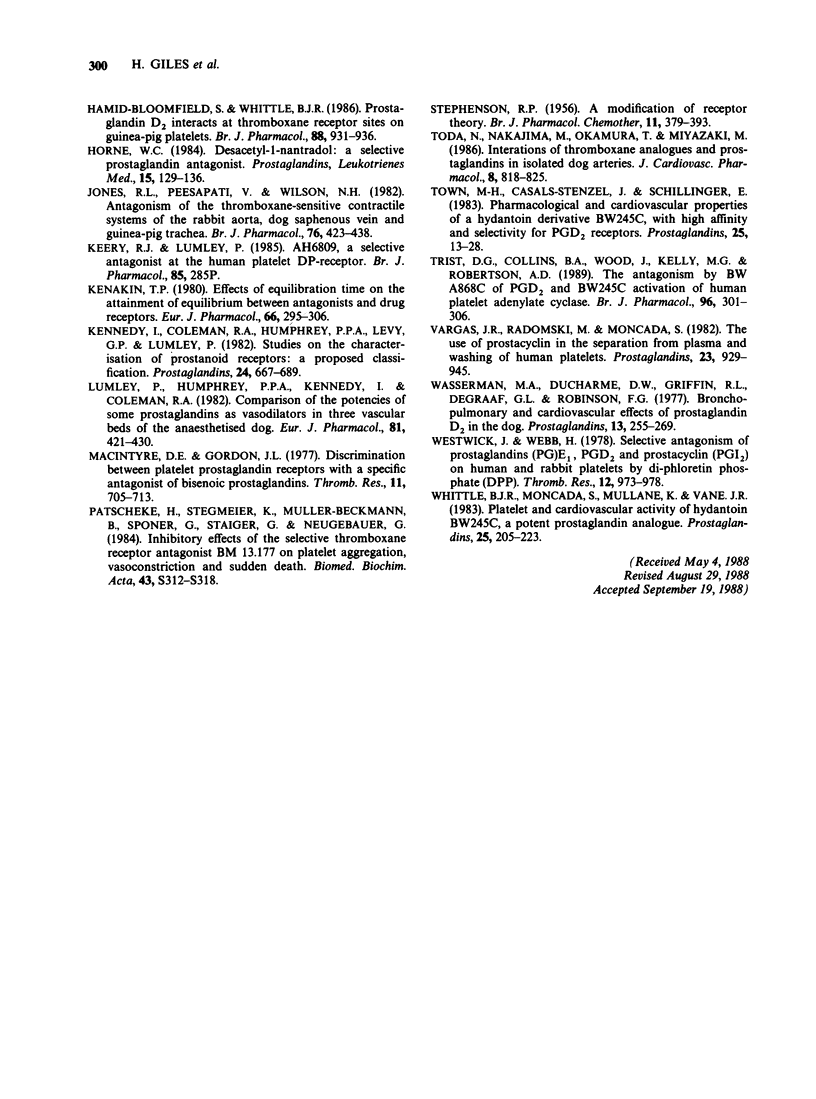
Selected References
These references are in PubMed. This may not be the complete list of references from this article.
- Black J. W., Leff P., Shankley N. P. Further analysis of anomalous pKB values for histamine H2-receptor antagonists on the mouse isolated stomach assay. Br J Pharmacol. 1985 Nov;86(3):581–587. doi: 10.1111/j.1476-5381.1985.tb08934.x. [DOI] [PMC free article] [PubMed] [Google Scholar]
- Black J. W., Leff P., Shankley N. P. Pharmacological analysis of the pentagastrin-tiotidine interaction in the mouse isolated stomach. Br J Pharmacol. 1985 Nov;86(3):589–599. doi: 10.1111/j.1476-5381.1985.tb08935.x. [DOI] [PMC free article] [PubMed] [Google Scholar]
- Coleman R. A., Humphrey P. P., Kennedy I., Levy G. P., Lumley P. U-46619, a selective thromboxane A2-like agonist? [proceedings]. Br J Pharmacol. 1980 Jan;68(1):127P–128P. [PMC free article] [PubMed] [Google Scholar]
- Coleman R. A., Kennedy I. Characterisation of the prostanoid receptors mediating contraction of guinea-pig isolated trachea. Prostaglandins. 1985 Mar;29(3):363–375. doi: 10.1016/0090-6980(85)90096-6. [DOI] [PubMed] [Google Scholar]
- Coleman R. A., Kennedy I. Contractile and relaxant actions of prostaglandins on guinea-pig isolated trachea. Br J Pharmacol. 1980 Mar;68(3):533–539. doi: 10.1111/j.1476-5381.1980.tb14569.x. [DOI] [PMC free article] [PubMed] [Google Scholar]
- Dong Y. J., Jones R. L., Wilson N. H. Prostaglandin E receptor subtypes in smooth muscle: agonist activities of stable prostacyclin analogues. Br J Pharmacol. 1986 Jan;87(1):97–107. doi: 10.1111/j.1476-5381.1986.tb10161.x. [DOI] [PMC free article] [PubMed] [Google Scholar]
- Dukes M., Russell W., Walpole A. L. Potent luteolytic agents related to prostaglandin F2alpha. Nature. 1974 Jul 26;250(464):330–331. doi: 10.1038/250330a0. [DOI] [PubMed] [Google Scholar]
- Hamid-Bloomfield S., Whittle B. J. Prostaglandin D2 interacts at thromboxane receptor-sites on guinea-pig platelets. Br J Pharmacol. 1986 Aug;88(4):931–936. doi: 10.1111/j.1476-5381.1986.tb16268.x. [DOI] [PMC free article] [PubMed] [Google Scholar]
- Hamid S., Whittle B. J. Interaction of prostaglandin D2 with prostacyclin, carbacyclin and the hydantoin prostaglandin, BW245C, in guinea-pig platelets. Br J Pharmacol. 1985 May;85(1):285–290. doi: 10.1111/j.1476-5381.1985.tb08858.x. [DOI] [PMC free article] [PubMed] [Google Scholar]
- Horne W. C. Desacetyl-1-nantradol: a selective prostaglandin antagonist. Prostaglandins Leukot Med. 1984 Jul;15(1):129–136. doi: 10.1016/0262-1746(84)90063-5. [DOI] [PubMed] [Google Scholar]
- Jones R. L., Peesapati V., Wilson N. H. Antagonism of the thromboxane-sensitive contractile systems of the rabbit aorta, dog saphenous vein and guinea-pig trachea. Br J Pharmacol. 1982 Jul;76(3):423–438. doi: 10.1111/j.1476-5381.1982.tb09236.x. [DOI] [PMC free article] [PubMed] [Google Scholar]
- Kenakin T. P. Effects of equilibration time on the attainment of equilibrium between antagonists and drug receptors. Eur J Pharmacol. 1980 Sep 5;66(4):295–306. doi: 10.1016/0014-2999(80)90462-8. [DOI] [PubMed] [Google Scholar]
- Kennedy I., Coleman R. A., Humphrey P. P., Levy G. P., Lumley P. Studies on the characterisation of prostanoid receptors: a proposed classification. Prostaglandins. 1982 Nov;24(5):667–689. doi: 10.1016/0090-6980(82)90036-3. [DOI] [PubMed] [Google Scholar]
- Lumley P., Humphrey P. P., Kennedy I., Coleman R. A. Comparison of the potencies of some prostaglandins as vasodilators in three vascular beds of the anaesthetised dog. Eur J Pharmacol. 1982 Jul 16;81(3):421–430. doi: 10.1016/0014-2999(82)90107-8. [DOI] [PubMed] [Google Scholar]
- MacIntyre D. E., Gordon J. L. Discrimination between platelet prostaglandin receptors with a specific antagonist of bisenoic prostaglandins. Thromb Res. 1977 Dec;11(6):705–713. doi: 10.1016/0049-3848(77)90099-8. [DOI] [PubMed] [Google Scholar]
- Patscheke H., Stegmeier K., Müller-Beckmann B., Sponer G., Staiger C., Neugebauer G. Inhibitory effects of the selective thromboxane receptor antagonist BM 13.177 on platelet aggregation, vasoconstriction and sudden death. Biomed Biochim Acta. 1984;43(8-9):S312–S318. [PubMed] [Google Scholar]
- STEPHENSON R. P. A modification of receptor theory. Br J Pharmacol Chemother. 1956 Dec;11(4):379–393. doi: 10.1111/j.1476-5381.1956.tb00006.x. [DOI] [PMC free article] [PubMed] [Google Scholar]
- Toda N., Nakajima M., Okamura T., Miyazaki M. Interactions of thromboxane A2 analogs and prostaglandins in isolated dog arteries. J Cardiovasc Pharmacol. 1986 Jul-Aug;8(4):818–825. doi: 10.1097/00005344-198709010-00025. [DOI] [PubMed] [Google Scholar]
- Town M. H., Casals-Stenzel J., Schillinger E. Pharmacological and cardiovascular properties of a hydantoin derivative, BW 245 C, with high affinity and selectivity for PGD2 receptors. Prostaglandins. 1983 Jan;25(1):13–28. doi: 10.1016/0090-6980(83)90131-4. [DOI] [PubMed] [Google Scholar]
- Trist D. G., Collins B. A., Wood J., Kelly M. G., Robertson A. D. The antagonism by BW A868C of PGD2 and BW245C activation of human platelet adenylate cyclase. Br J Pharmacol. 1989 Feb;96(2):301–306. doi: 10.1111/j.1476-5381.1989.tb11817.x. [DOI] [PMC free article] [PubMed] [Google Scholar]
- Vargas J. R., Radomski M., Moncada S. The use of prostacyclin in the separation from plasma and washing of human platelets. Prostaglandins. 1982 Jun;23(6):929–945. doi: 10.1016/0090-6980(82)90135-6. [DOI] [PubMed] [Google Scholar]
- Wasserman M. A., DuCharme D. W., Griffin R. L., DeGraaf G. L., Robinson F. G. Bronchopulmonary and cardiovascular effects of prostaglandin D2 in the dog. Prostaglandins. 1977 Feb;13(2):255–269. doi: 10.1016/0090-6980(77)90007-7. [DOI] [PubMed] [Google Scholar]
- Westwick J., Webb H. Selective antagonism of prostaglandin (PG) E1, PGD2 and prostacyclin (PGI2) on human and rabbit platelets by di-4-phloretin phosphate (DPP). Thromb Res. 1978 Jun;12(6):973–978. doi: 10.1016/0049-3848(78)90053-1. [DOI] [PubMed] [Google Scholar]
- Whittle B. J., Moncada S., Mullane K., Vane J. R. Platelet and cardiovascular activity of the hydantoin BW245C, a potent prostaglandin analogue. Prostaglandins. 1983 Feb;25(2):205–223. doi: 10.1016/0090-6980(83)90105-3. [DOI] [PubMed] [Google Scholar]


